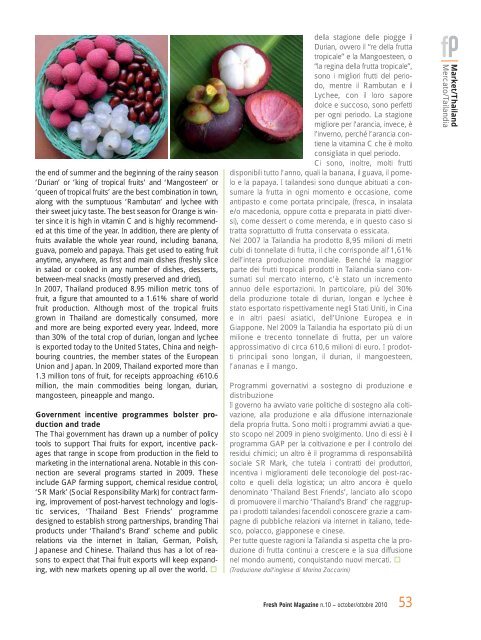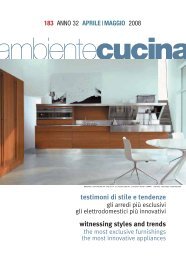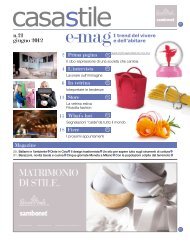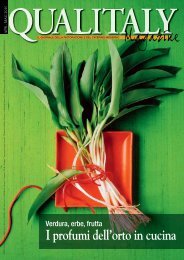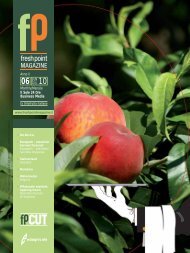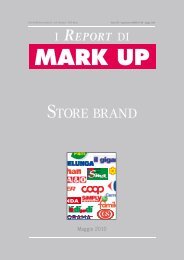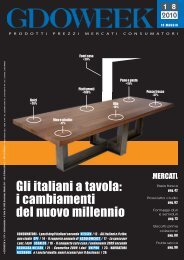Fresh Point Magazine - B2B24 - Il Sole 24 Ore
Fresh Point Magazine - B2B24 - Il Sole 24 Ore
Fresh Point Magazine - B2B24 - Il Sole 24 Ore
Create successful ePaper yourself
Turn your PDF publications into a flip-book with our unique Google optimized e-Paper software.
the end of summer and the beginning of the rainy season<br />
‘Durian’ or ‘king of tropical fruits’ and ‘Mangosteen’ or<br />
‘queen of tropical fruits’ are the best combination in town,<br />
along with the sumptuous ‘Rambutan’ and lychee with<br />
their sweet juicy taste. The best season for Orange is winter<br />
since it is high in vitamin C and is highly recommended<br />
at this time of the year. In addition, there are plenty of<br />
fruits available the whole year round, including banana,<br />
guava, pomelo and papaya. Thais get used to eating fruit<br />
anytime, anywhere, as first and main dishes (freshly slice<br />
in salad or cooked in any number of dishes, desserts,<br />
between-meal snacks (mostly preserved and dried).<br />
In 2007, Thailand produced 8.95 million metric tons of<br />
fruit, a figure that amounted to a 1.61% share of world<br />
fruit production. Although most of the tropical fruits<br />
grown in Thailand are domestically consumed, more<br />
and more are being exported every year. Indeed, more<br />
than 30% of the total crop of durian, longan and lychee<br />
is exported today to the United States, China and neighbouring<br />
countries, the member states of the European<br />
Union and Japan. In 2009, Thailand exported more than<br />
1.3 million tons of fruit, for receipts approaching €610.6<br />
million, the main commodities being longan, durian,<br />
mangosteen, pineapple and mango.<br />
Government incentive programmes bolster production<br />
and trade<br />
The Thai government has drawn up a number of policy<br />
tools to support Thai fruits for export, incentive packages<br />
that range in scope from production in the field to<br />
marketing in the international arena. Notable in this connection<br />
are several programs started in 2009. These<br />
include GAP farming support, chemical residue control,<br />
‘SR Mark’ (Social Responsibility Mark) for contract farming,<br />
improvement of post-harvest technology and logistic<br />
services, ‘Thailand Best Friends’ programme<br />
designed to establish strong partnerships, branding Thai<br />
products under ‘Thailand's Brand’ scheme and public<br />
relations via the internet in Italian, German, Polish,<br />
Japanese and Chinese. Thailand thus has a lot of reasons<br />
to expect that Thai fruit exports will keep expanding,<br />
with new markets opening up all over the world.<br />
della stagione delle piogge il<br />
Durian, ovvero il “re della frutta<br />
tropicale” e la Mangoesteen, o<br />
“la regina della frutta tropicale”,<br />
sono i migliori frutti del periodo,<br />
mentre il Rambutan e il<br />
Lychee, con il loro sapore<br />
dolce e succoso, sono perfetti<br />
per ogni periodo. La stagione<br />
migliore per l’arancia, invece, è<br />
l’inverno, perché l’arancia contiene<br />
la vitamina C che è molto<br />
consigliata in quel periodo.<br />
Ci sono, inoltre, molti frutti<br />
disponibili tutto l’anno, quali la banana, il guava, il pomelo<br />
e la papaya. I tailandesi sono dunque abituati a consumare<br />
la frutta in ogni momento e occasione, come<br />
antipasto e come portata principale, (fresca, in insalata<br />
e/o macedonia, oppure cotta e preparata in piatti diversi),<br />
come dessert o come merenda, e in questo caso si<br />
tratta soprattutto di frutta conservata o essicata.<br />
Nel 2007 la Tailandia ha prodotto 8,95 milioni di metri<br />
cubi di tonnellate di frutta, il che corrisponde all’1,61%<br />
dell’intera produzione mondiale. Benché la maggior<br />
parte dei frutti tropicali prodotti in Tailandia siano consumati<br />
sul mercato interno, c’è stato un incremento<br />
annuo delle esportazioni. In particolare, più del 30%<br />
della produzione totale di durian, longan e lychee è<br />
stato esportato rispettivamente negli Stati Uniti, in Cina<br />
e in altri paesi asiatici, dell’Unione Europea e in<br />
Giappone. Nel 2009 la Tailandia ha esportato più di un<br />
milione e trecento tonnellate di frutta, per un valore<br />
approssimativo di circa 610,6 milioni di euro. I prodotti<br />
principali sono longan, il durian, il mangoesteen,<br />
l’ananas e il mango.<br />
Programmi governativi a sostegno di produzione e<br />
distribuzione<br />
<strong>Il</strong> governo ha avviato varie politiche di sostegno alla coltivazione,<br />
alla produzione e alla diffusione internazionale<br />
della propria frutta. Sono molti i programmi avviati a questo<br />
scopo nel 2009 in pieno svolgimento. Uno di essi è il<br />
programma GAP per la coltivazione e per il controllo dei<br />
residui chimici; un altro è il programma di responsabilità<br />
sociale SR Mark, che tutela i contratti dei produttori,<br />
incentiva i miglioramenti delle teconologie del post-raccolto<br />
e quelli della logistica; un altro ancora è quello<br />
denominato ‘Thailand Best Friends’, lanciato allo scopo<br />
di promuovere il marchio ‘Thailand’s Brand’ che raggruppa<br />
i prodotti tailandesi facendoli conoscere grazie a campagne<br />
di pubbliche relazioni via internet in italiano, tedesco,<br />
polacco, giapponese e cinese.<br />
Per tutte queste ragioni la Tailandia si aspetta che la produzione<br />
di frutta continui a crescere e la sua diffusione<br />
nel mondo aumenti, conquistando nuovi mercati.<br />
(Traduzione dall’inglese di Marina Zaccarini)<br />
<strong>Fresh</strong> <strong>Point</strong> <strong>Magazine</strong> n.10 – october/ottobre 2010<br />
53<br />
Market/Thailand<br />
Mercato/Tailandia


